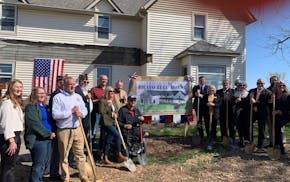Park Commissioner Scott Vreeland's pet rocks are now in place at Bohemian Flats below the Washington Avenue Bridge that's being used as a construction staging area.
The rocks are the remains of piers that once supported the original Franklin Avenue Bridge, constructed in 1889.
The Coast Guard ordered the piers removed — something that was supposed to occur when the current bridge was built in the early 1920s — as part of the current $50 million bridge rehab project.
Vreeland expressed affection for the piers and advocated in an online forum that they be spared. But Hennepin County said it concluded that rather than save money by leaving them in place, doing so would add to the construction budget by complicating construction access and requiring pier stabilization to avoid further deterioration.
The county and contractor offered the rocks to the Minneapolis Park and Recreation Board, since they would be offloaded from a construction barge at Bohemian Flats. Vreeland said the ultimate use of the rocks will be up to the full board, but he's fine with incorporating them into the park, which is headed for its own renovation.
The Park Board's capital plan earmarks $5.4 million in state funding for revamping the park from 2016 through 2019. It's not yet determined how that money will be spent. A plan was drawn up around 1988 that included a toboggan run, Vreeland said, but there's no evidence it was approved by the board.
Vreeland said much of the money could be consumed in repairs to the park's sea wall, portions of which date back to the long period when much of the park was used as a city barge terminal. More recently, it has been used first to store wrecked beams from the Interstate 35W bridge collapse and now by the contractor for the Franklin bridge work.
The flats lack close residents, unlike many parks. Vreeland said he's content to leave the park as open space. It has a dock for excursion boats, a small pavilion and exactly one panel interpreting the area's rich history as a squatter village for immigrants.
Vreeland said he'd like to see a floating restaurant and more interpretation of the area's history. The wooden homes occupied the flats between just upriver from Northern Pacific Bridge No. 9 and the Washington bridge. They flooded periodically, but their occupants, many from Eastern Europe, were resilient. Some moved on as their economic fortunes improved; others were moved out when the terminal was expanded by the 1950s.
Meanwhile, the county said its contractor is constructing the coffer dams that will allow it to work on the base of the piers that support the current bridge.
Steve Brandt • 612-673-4438
Twitter: @brandtstrib

Protesters briefly clash at dual pro-Israel, pro-Palestinian rallies at the University of Minnesota

Defense attorneys in Feeding Our Future trial cast doubt on FBI's meal fraud investigation

Overdose deaths spike after incarceration, but Minnesota jails lack treatment

